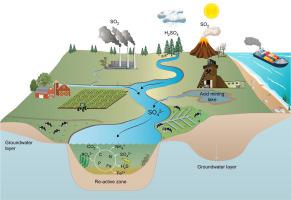当前位置:
X-MOL 学术
›
Earth Sci. Rev.
›
论文详情
Our official English website, www.x-mol.net, welcomes your
feedback! (Note: you will need to create a separate account there.)
Sulphate in freshwater ecosystems: A review of sources, biogeochemical cycles, ecotoxicological effects and bioremediation
Earth-Science Reviews ( IF 10.8 ) Pub Date : 2021-01-01 , DOI: 10.1016/j.earscirev.2020.103446 Dominik Zak , Michael Hupfer , Alvaro Cabezas , Gerald Jurasinski , Joachim Audet , Andreas Kleeberg , Robert McInnes , Søren Munch Kristiansen , Rasmus Jes Petersen , Haojie Liu , Tobias Goldhammer
Earth-Science Reviews ( IF 10.8 ) Pub Date : 2021-01-01 , DOI: 10.1016/j.earscirev.2020.103446 Dominik Zak , Michael Hupfer , Alvaro Cabezas , Gerald Jurasinski , Joachim Audet , Andreas Kleeberg , Robert McInnes , Søren Munch Kristiansen , Rasmus Jes Petersen , Haojie Liu , Tobias Goldhammer

|
Abstract Sulphate (SO42-) concentrations in freshwaters have increased globally over the last decades even though a strong reduction in atmospheric sulphur (S) deposition has occurred across large parts of North America and Europe. However, the extent and effects of increased SO42- concentrations in freshwater and terrestrial ecosystems remain poorly understood regarding many aspects of ecosystem structure and functioning. Here, we review the sources of SO42- pollution, environmental impacts on freshwater ecosystems and bioremediation opportunites and we identify key knowledge gaps and future research needs. Natural sources of dissolved SO42- in freshwater ecosystems include mineral weathering, volcanic activity, decomposition and combustion of organic matter, oxidation of sulphides, and sea spray aerosols. Acid mine drainage, fertiliser leaching from agricultural soils, wetland drainage, agricultural and industrial wastewater runoff as well as sea level changes are the main direct and indirect sources of the anthropogenic SO42- input to waterbodies. Increasing SO42- concentrations in freshwater systems influence the biogeochemical processes of carbon, nitrogen and phosphorus. Similarly, iron availability can be critical in determining the adverse effects of SO42- on environmental receptors. The literature reviewed clearly demonstrates that SO42- pollution may have toxic effects on aquatic plants and animal organisms, including, among others, fishes, invertebrates and amphibians, and it may also have negative implications for human health. Bioremediation systems provide opportunities to mitigate the impacts of SO42-, but removal efficiencies range widely from 0% to 70% across treatment systems such as constructed wetlands, permeable reactive barriers and bioreactors. We conclude that examination of increased SO42- concentrations and fluxes at different spatial scales is urgently needed as the ongoing global perturbation of the S cycle is likely to be accelerated by climate change and human development activities. The adverse effects of this on freshwater organisms worldwide may prove detrimental to the future well-being of humans and ecosystems. Field-scale research to estimate the ecotoxicological effects of elevated SO42- concentrations is recommended as is widespread implementation of large-scale wetland restoration and bioremediation systems to reduce SO42- loads on freshwater ecosystems.
中文翻译:

淡水生态系统中的硫酸盐:来源、生物地球化学循环、生态毒理学效应和生物修复的综述
摘要 在过去的几十年中,尽管北美和欧洲大部分地区的大气硫 (S) 沉积量大幅减少,但淡水中的硫酸盐 (SO42-) 浓度在全球范围内有所增加。然而,淡水和陆地生态系统中 SO42- 浓度增加的程度和影响在生态系统结构和功能的许多方面仍然知之甚少。在这里,我们回顾了 SO42 污染的来源、对淡水生态系统的环境影响和生物修复机会,并确定了关键的知识差距和未来的研究需求。淡水生态系统中溶解的 SO42- 的天然来源包括矿物风化、火山活动、有机物的分解和燃烧、硫化物的氧化和海浪气溶胶。酸性矿山排水,农业土壤中的肥料浸出、湿地排水、农业和工业废水径流以及海平面变化是人为 SO42 输入水体的主要直接和间接来源。增加淡水系统中 SO42- 浓度会影响碳、氮和磷的生物地球化学过程。同样,铁的可用性对于确定 SO42- 对环境受体的不利影响至关重要。查阅的文献清楚地表明,SO42 污染可能对水生植物和动物有机体产生毒性影响,其中包括鱼类、无脊椎动物和两栖动物,也可能对人类健康产生负面影响。生物修复系统提供了减轻 SO42-、但在人工湿地、渗透性反应屏障和生物反应器等处理系统中,去除效率从 0% 到 70% 不等。我们得出的结论是,由于气候变化和人类发展活动可能会加速 S 循环的持续全球扰动,因此迫切需要检查不同空间尺度上增加的 SO42 浓度和通量。这对全世界淡水生物的不利影响可能对人类和生态系统的未来福祉有害。建议进行实地规模的研究,以评估 SO42- 浓度升高的生态毒理学影响,同时广泛实施大规模湿地恢复和生物修复系统,以减少淡水生态系统中的 SO42- 负荷。可渗透的反应屏障和生物反应器。我们得出的结论是,由于气候变化和人类发展活动可能会加速 S 循环的持续全球扰动,因此迫切需要检查不同空间尺度上增加的 SO42 浓度和通量。这对全世界淡水生物的不利影响可能对人类和生态系统的未来福祉有害。建议进行实地规模的研究,以评估 SO42- 浓度升高的生态毒理学影响,同时广泛实施大规模湿地恢复和生物修复系统,以减少淡水生态系统中的 SO42- 负荷。可渗透的反应屏障和生物反应器。我们得出的结论是,由于气候变化和人类发展活动可能会加速 S 循环的持续全球扰动,因此迫切需要检查不同空间尺度上增加的 SO42 浓度和通量。这对全世界淡水生物的不利影响可能对人类和生态系统的未来福祉有害。建议进行实地规模的研究,以评估 SO42- 浓度升高的生态毒理学影响,同时广泛实施大规模湿地恢复和生物修复系统,以减少淡水生态系统中的 SO42- 负荷。我们得出的结论是,由于气候变化和人类发展活动可能会加速 S 循环的持续全球扰动,因此迫切需要检查不同空间尺度上增加的 SO42 浓度和通量。这对全世界淡水生物的不利影响可能对人类和生态系统的未来福祉有害。建议进行实地规模的研究,以评估 SO42- 浓度升高的生态毒理学影响,同时广泛实施大规模湿地恢复和生物修复系统,以减少淡水生态系统中的 SO42- 负荷。我们得出的结论是,由于气候变化和人类发展活动可能会加速 S 循环的持续全球扰动,因此迫切需要检查不同空间尺度上增加的 SO42 浓度和通量。这对全世界淡水生物的不利影响可能对人类和生态系统的未来福祉有害。建议进行实地规模的研究,以评估 SO42- 浓度升高的生态毒理学影响,同时广泛实施大规模湿地恢复和生物修复系统,以减少淡水生态系统中的 SO42- 负荷。这对全世界淡水生物的不利影响可能对人类和生态系统的未来福祉有害。建议进行实地规模研究,以评估 SO42- 浓度升高的生态毒理学影响,同时广泛实施大规模湿地恢复和生物修复系统,以减少淡水生态系统中的 SO42- 负荷。这对全世界淡水生物的不利影响可能对人类和生态系统的未来福祉有害。建议进行实地规模的研究,以评估 SO42- 浓度升高的生态毒理学影响,同时广泛实施大规模湿地恢复和生物修复系统,以减少淡水生态系统中的 SO42- 负荷。
更新日期:2021-01-01
中文翻译:

淡水生态系统中的硫酸盐:来源、生物地球化学循环、生态毒理学效应和生物修复的综述
摘要 在过去的几十年中,尽管北美和欧洲大部分地区的大气硫 (S) 沉积量大幅减少,但淡水中的硫酸盐 (SO42-) 浓度在全球范围内有所增加。然而,淡水和陆地生态系统中 SO42- 浓度增加的程度和影响在生态系统结构和功能的许多方面仍然知之甚少。在这里,我们回顾了 SO42 污染的来源、对淡水生态系统的环境影响和生物修复机会,并确定了关键的知识差距和未来的研究需求。淡水生态系统中溶解的 SO42- 的天然来源包括矿物风化、火山活动、有机物的分解和燃烧、硫化物的氧化和海浪气溶胶。酸性矿山排水,农业土壤中的肥料浸出、湿地排水、农业和工业废水径流以及海平面变化是人为 SO42 输入水体的主要直接和间接来源。增加淡水系统中 SO42- 浓度会影响碳、氮和磷的生物地球化学过程。同样,铁的可用性对于确定 SO42- 对环境受体的不利影响至关重要。查阅的文献清楚地表明,SO42 污染可能对水生植物和动物有机体产生毒性影响,其中包括鱼类、无脊椎动物和两栖动物,也可能对人类健康产生负面影响。生物修复系统提供了减轻 SO42-、但在人工湿地、渗透性反应屏障和生物反应器等处理系统中,去除效率从 0% 到 70% 不等。我们得出的结论是,由于气候变化和人类发展活动可能会加速 S 循环的持续全球扰动,因此迫切需要检查不同空间尺度上增加的 SO42 浓度和通量。这对全世界淡水生物的不利影响可能对人类和生态系统的未来福祉有害。建议进行实地规模的研究,以评估 SO42- 浓度升高的生态毒理学影响,同时广泛实施大规模湿地恢复和生物修复系统,以减少淡水生态系统中的 SO42- 负荷。可渗透的反应屏障和生物反应器。我们得出的结论是,由于气候变化和人类发展活动可能会加速 S 循环的持续全球扰动,因此迫切需要检查不同空间尺度上增加的 SO42 浓度和通量。这对全世界淡水生物的不利影响可能对人类和生态系统的未来福祉有害。建议进行实地规模的研究,以评估 SO42- 浓度升高的生态毒理学影响,同时广泛实施大规模湿地恢复和生物修复系统,以减少淡水生态系统中的 SO42- 负荷。可渗透的反应屏障和生物反应器。我们得出的结论是,由于气候变化和人类发展活动可能会加速 S 循环的持续全球扰动,因此迫切需要检查不同空间尺度上增加的 SO42 浓度和通量。这对全世界淡水生物的不利影响可能对人类和生态系统的未来福祉有害。建议进行实地规模的研究,以评估 SO42- 浓度升高的生态毒理学影响,同时广泛实施大规模湿地恢复和生物修复系统,以减少淡水生态系统中的 SO42- 负荷。我们得出的结论是,由于气候变化和人类发展活动可能会加速 S 循环的持续全球扰动,因此迫切需要检查不同空间尺度上增加的 SO42 浓度和通量。这对全世界淡水生物的不利影响可能对人类和生态系统的未来福祉有害。建议进行实地规模的研究,以评估 SO42- 浓度升高的生态毒理学影响,同时广泛实施大规模湿地恢复和生物修复系统,以减少淡水生态系统中的 SO42- 负荷。我们得出的结论是,由于气候变化和人类发展活动可能会加速 S 循环的持续全球扰动,因此迫切需要检查不同空间尺度上增加的 SO42 浓度和通量。这对全世界淡水生物的不利影响可能对人类和生态系统的未来福祉有害。建议进行实地规模的研究,以评估 SO42- 浓度升高的生态毒理学影响,同时广泛实施大规模湿地恢复和生物修复系统,以减少淡水生态系统中的 SO42- 负荷。这对全世界淡水生物的不利影响可能对人类和生态系统的未来福祉有害。建议进行实地规模研究,以评估 SO42- 浓度升高的生态毒理学影响,同时广泛实施大规模湿地恢复和生物修复系统,以减少淡水生态系统中的 SO42- 负荷。这对全世界淡水生物的不利影响可能对人类和生态系统的未来福祉有害。建议进行实地规模的研究,以评估 SO42- 浓度升高的生态毒理学影响,同时广泛实施大规模湿地恢复和生物修复系统,以减少淡水生态系统中的 SO42- 负荷。











































 京公网安备 11010802027423号
京公网安备 11010802027423号